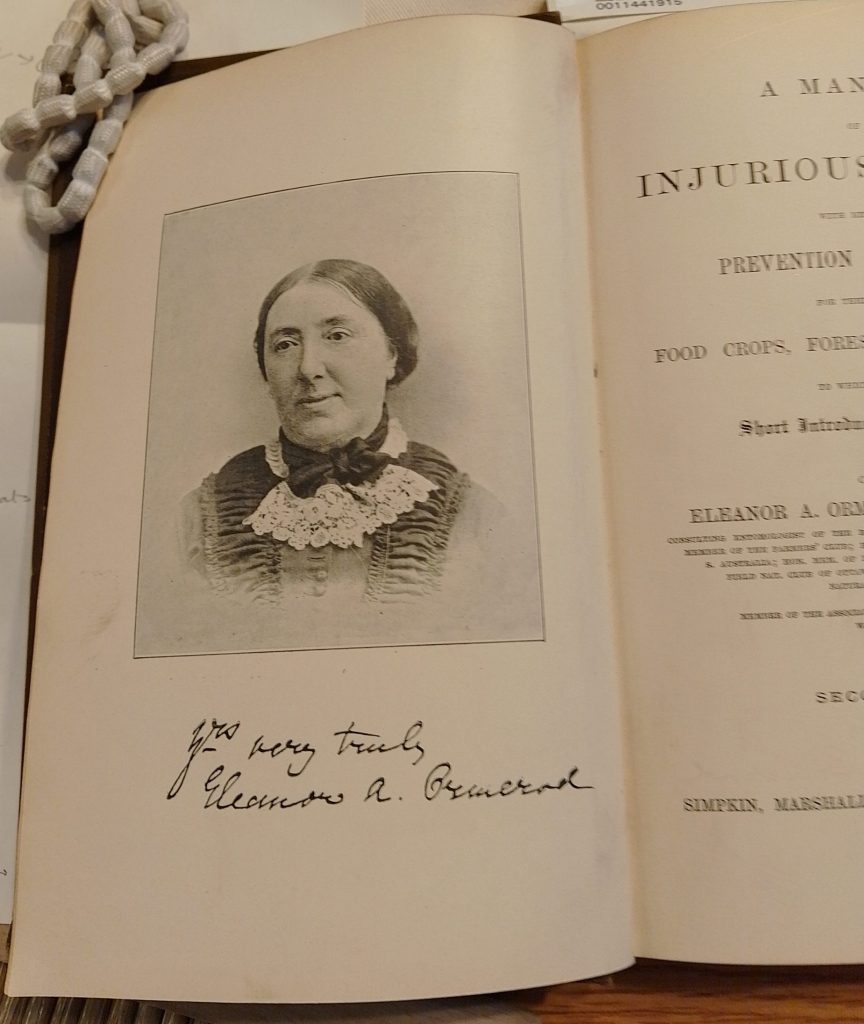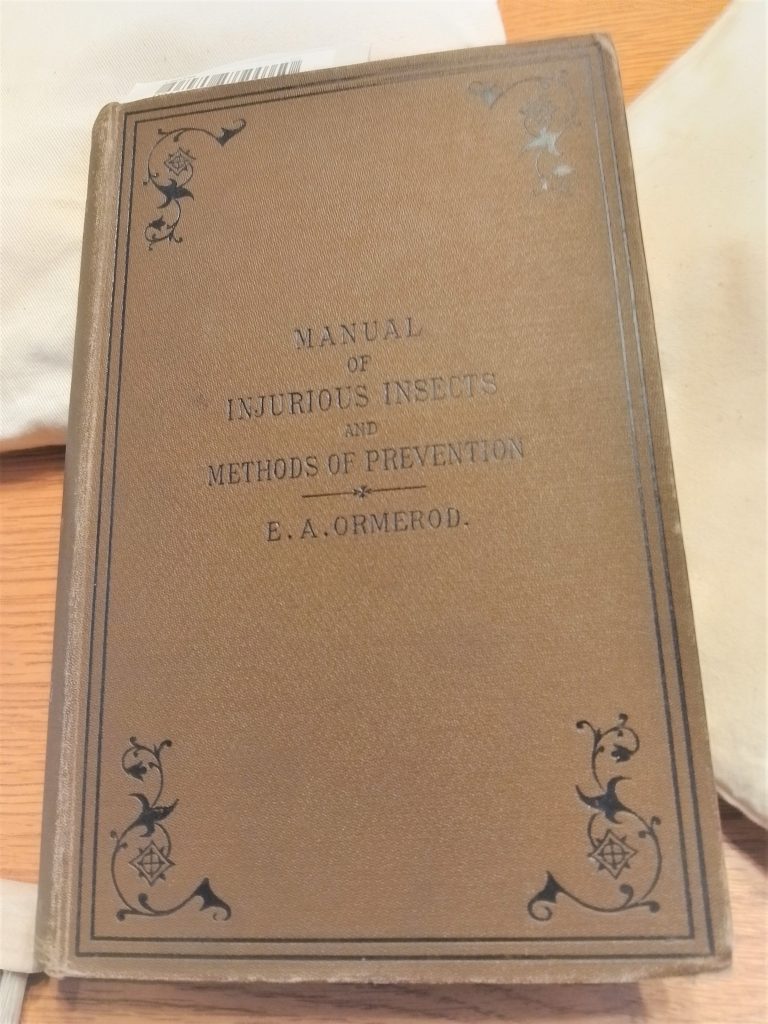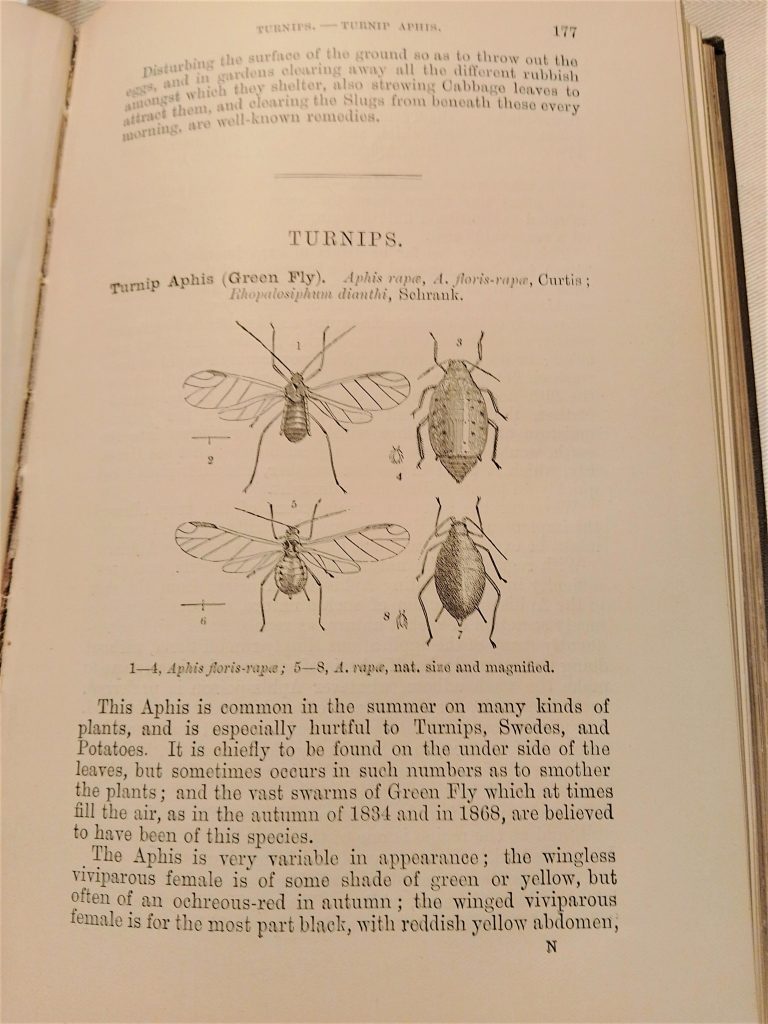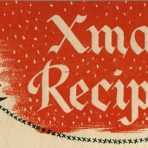From the seventeenth century, women have played a small but significant role in exploring the world of insects by listing, drawing, and collecting them. Some women have also observed and recorded the extraordinary life histories of insects. Eleanor Anne Ormerod (1828-1901) did all this before becoming the first woman to make a scientific study of insect pests of garden and farm in Britain. She is the author of A manual of Injurious Insects (Ormerod 1890) which is held in the LSHTM Library.

Portrait of Eleanor Ormerod
Eleanor Anne Ormerod was born into a wealthy family on 1 May 1828 and grew up on the family’s 800-acre estate, Sedbury Park, in Gloucestershire, the youngest of ten children of George Ormerod (1785-1873). Eleanor and her two sisters were home-schooled by their mother and their early years were devoted to philanthropic acts in the local parishes. Sarah Ormerod (1784-1860), their mother, was a botanical artist. In 1852 Eleanor started teaching herself entomology. Where others were content to collect pretty butterflies, Eleanor put her new knowledge to practical use. As she travelled across the farm she gathered first-hand insight into the damage insects caused some crops affecting annual grain yields, and the devastations they wrought on farmers’ livelihoods. When the Royal Horticultural Society put out a request to the public in 1868 to send it specimens of insects, both harmful and beneficial, to British agriculture and horticulture, Eleanor was well qualified to join in this early example of citizen science, and for her continued contributions she was awarded their silver medal in 1870.
Before reaching this level of expertise, Eleanor spent many hours in the field patiently watching the insects before collecting them to study at home. Equipment necessary to collect and study insects included: nets for catching flying insects, traps for others, preserving bottles, cotton wool for protection, pins to secure specimens to cards, labels, boxes, killing agents, a dissecting kit, a hand lens, a microscope and microscope slides and staining agents. The expense of this equipment was not a problem for Eleanor who had financial independence and leisure to pursue her interests. Eleanor’s position in the upper echelons of society, where her father, a historian, was a Fellow of the Royal Society (FRS), meant she had an entre to the landed gentry from whom she regularly sought advice and who are acknowledged in her book. After the death of the autocratic George Ormerod in 1873, Eleanor started publishing her research in the journals of learned societies and gave lectures at agricultural colleges. She was, from 1882-1891, consulting entomologist to the Royal Agricultural Society of England and unofficial government entomologist from 1877-1901, during which time she sent out questionnaires to landowners and others across the country and reported the results in annual reports. She received no salary.
Unlike the papers published in the journals of the Entomological and Linnean societies, A Manual of Injurious Insects was written for farmers and gardeners to help them to identify insect pests on their land. It was first published in 1881, followed by a second edition, the one which is held in LSHTM Library, which was published in 1890. It gave practical advice with the aid of numerous line drawings for identifying pests at different stages of their life cycles, and remedies for eradicating them.


The contents are arranged under three headings: Food crops and insects that injure them; Forest trees and insects that injure them; and Fruit crops and insects that injure them. Under each heading the plants are arranged alphabetically. For example, in the Food crops category, Beans … Clover … Mangolds … Turnips. Under each plant type the insect pests that ravaged them are listed, together with advice on how to control the pests. Unsurprisingly, there is also an entry for slugs – molluscs that are universally more destructive of the gardener’s precious crops than any insect (Ormerod 1890 : 174-177). The book concludes with an ‘Introduction to entomology’ (Ormerod 1890 : 373-396).
Some advice in the Manual would now be considered dangerous or unlawful. For example, the use of Paris green, an acetoarsenite insecticide (Ormerod 1890 : 352-360), which is highly poisonous and responsible for the destruction of harmless fauna and flora. Eleanor also entered into a public debate about the house sparrow in which she supported the extermination of the birds on the grounds that they were seed-eaters feeding on farmers’ corn crops (Ormerod & Tegetmeier, 1897). Others defended the sparrow because it ate the insect pests. Despite the slaughter and dissection of thousands of sparrows to examine their stomach contents, no conclusion was reached.
In 1887 Eleanor and her elder sister Georgiana Ormerod (1823-1896), a talented entomological artist, moved to St Albans in Hertfordshire. The sisters were close and Georgiana regularly accompanied Eleanor in the field, and her drawings were used in Eleanor’s publications and lectures. Neither sister married and Eleanor died of liver cancer at her home in St Albans on 19 July 1901.
The LSHTM Library copy of A Manual of Injurious Insects, published in 1890,was acquired in 1959. It is still in its original publisher’s decorated cloth binding with the price – 5/- – stamped on the spine.
References
CLARK, J.F.M., 1992. Eleanor Ormerod (1828-1901) as an economic entomologist : ‘pioneer of purity even more than of Paris Green’. British Journal for the History of Science 25 : 431-452; core/content/view/0E16757EF7B90F6CFB6583CE88F43BCF/S0007087400029599a.pdf/div-class-title-eleanor-ormerod-1828-1901-as-an-economic-entomologist-pioneer-of-purity-even-more-than-of-paris-green-a-href-fn01-ref-type-fn-a-div.pdf
CLARK, J.F.M., 2004. Ormerod, Eleanor Anne. Oxford Dictionary if National Biography 41 : 941-944 port.
CLARK, J.F.M., 2009. Bugs and the Victorians. New Haven and London : Yale University Press. Chapter 8. A female entomologist, pp. 154-186.
ORMEROD, E.A., 1890. A Manual of Injurious Insects with methods of prevention and remedy for their attacks to food crops, forest trees, and fruit. To which is appended a short introduction to entomology. 2nd ed. London : Simpkin, Marshall, Hamilton, Kent & Co. xiv, 410 [2] p., ill. ports. (LSHTM Library *NA 1890); https://www.biodiversitylibrary.org/bibliography/106966 (this link is to the 1881 copy).
ORMEROD, E.A., 1892. A Text-book of Agricultural Entomology. A Guide to Methods of Insect Life and means of prevention of insect ravage. London : Simpkin,Marshall, Hamilton, Kent. xvi, 238 p., 163 text figs. https://www.biodiversitylibrary.org/bibliography/9228
ORMEROD, E.A. & TEGETMEIER, W.B., 1897. The House Sparrow (Passer domesticus, Linnaeus). [London : The Authors]. https://www.biodiversitylibrary.org/bibliography/153536L.
LSHTM Library Rare Books Collection Blogs is an occasional posting highlighting books that are landmarks in the understanding of tropical medicine and public health. The Rare Books Collection was initiated by Cyril Cuthbert Barnard (1894-1959), the first Librarian, from donations and purchases, assisted with grants from the Carnegie United Kingdom Trust. There are approximately 1600 historically important rare and antiquarian books in the Rare Books Collection.
Many of the LSHTM Library’s rare books were digitized as part of the UK Medical Heritage Library. This provides high-quality copyright-free downloads of over 200,000 books and pamphlets for the 19th and early 20th century. To help preserve the rare books, please consult the digital copy in the first instance.
If the book has not been digitized or if you need to consult the physical object, please request access on the Library’s Discover search service. Use the search function to find the book you would like to view. Click the title to view more information and then click ‘Request’. You can also email library@lshtm.ac.uk with details of the item you wish to view. A librarian will get in touch to arrange a time for you to view the item.
Researchers wishing to view the physical rare books must abide by the Guidelines for using the archives and complete and sign a registration form which signifies their agreement to abide by the archive rules. More information is available on the Visiting Archives webpage.



